BSc Business Law BMP4002: Report on UK Legal Context for Businesses
VerifiedAdded on 2023/06/10
|8
|2033
|435
Report
AI Summary
This report provides an overview of the legal context for business organizations in the UK, focusing on key sources of law and different legal structures such as sole proprietorships, general partnerships, and limited liability companies. It discusses relevant legislation like the Employment Rights Act 1996, the Equality Act 2010, and the Health and Safety at Work Act 1974. The report also touches upon the doctrine of vicarious liability and the legal responsibilities of company directors. Furthermore, it examines the components of a company's memorandum and articles of association. The report concludes with recommendations for IOM Solutions, suggesting a partnership business structure to alleviate pressure and reduce the burden of meeting market demands, highlighting the ease of formation and shared responsibilities within a partnership. Desklib offers a variety of resources, including past papers and solved assignments, to support students in their academic pursuits.
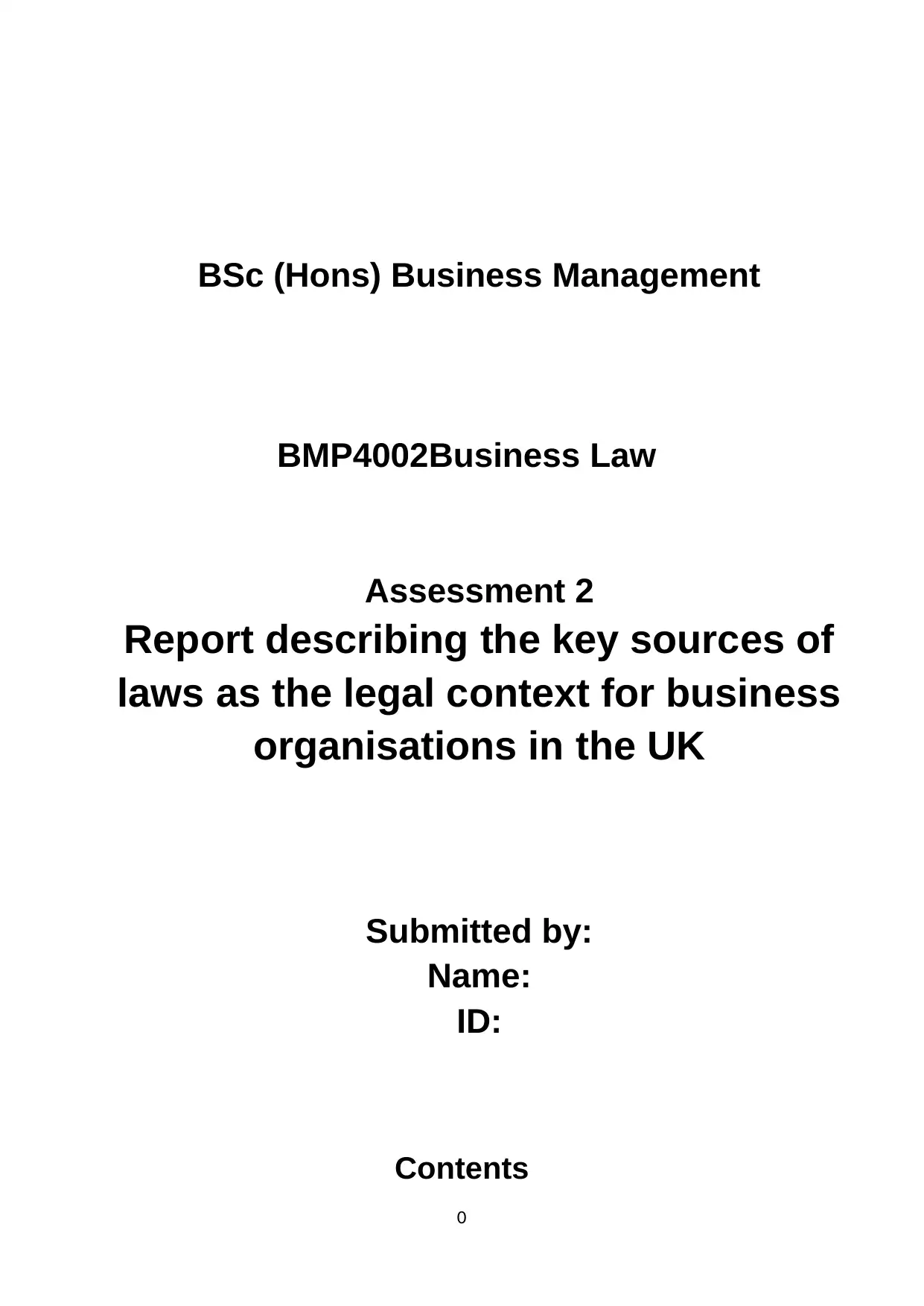
BSc (Hons) Business Management
BMP4002Business Law
Assessment 2
Report describing the key sources of
laws as the legal context for business
organisations in the UK
Submitted by:
Name:
ID:
Contents
0
BMP4002Business Law
Assessment 2
Report describing the key sources of
laws as the legal context for business
organisations in the UK
Submitted by:
Name:
ID:
Contents
0
Paraphrase This Document
Need a fresh take? Get an instant paraphrase of this document with our AI Paraphraser
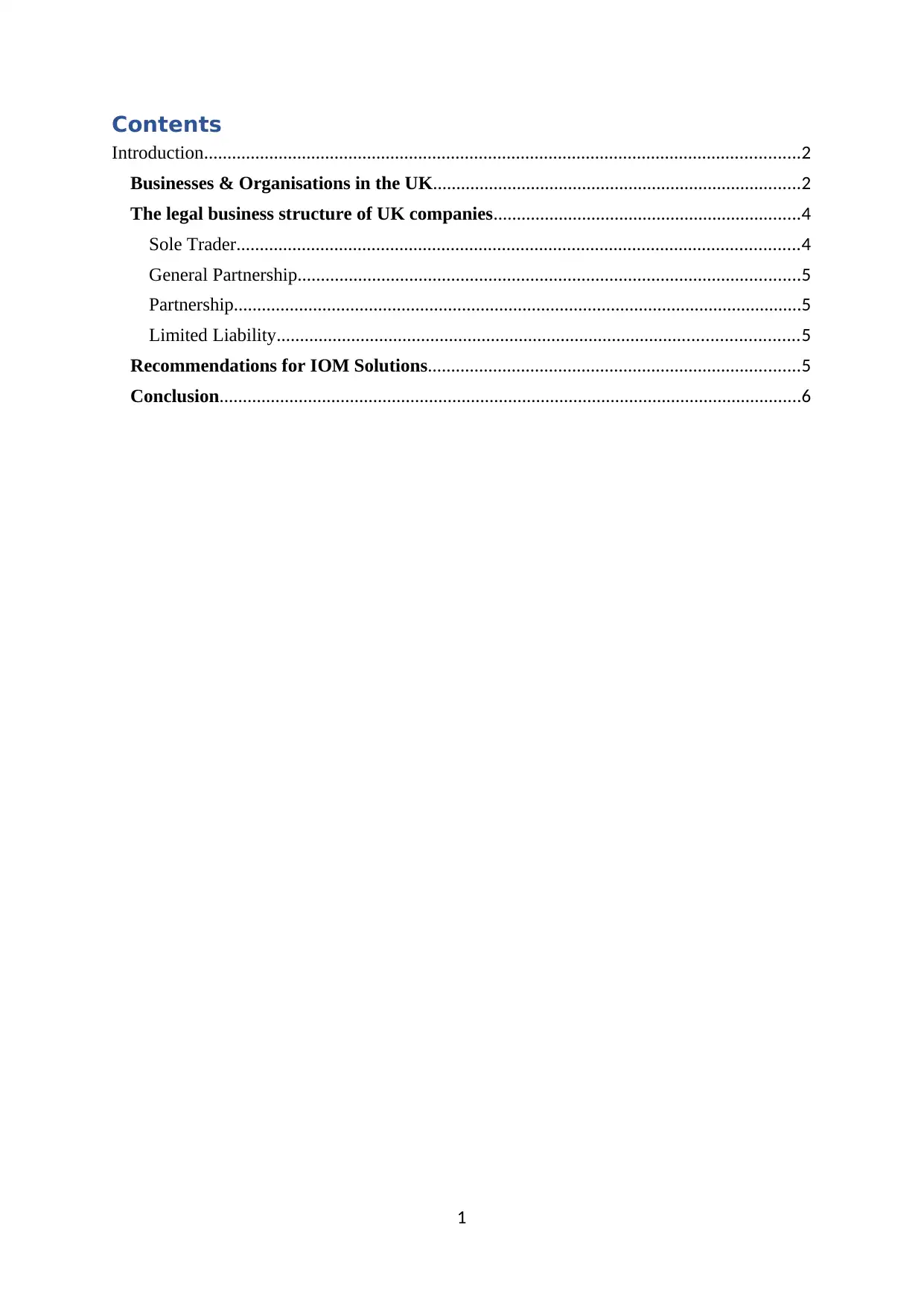
Contents
Introduction................................................................................................................................2
Businesses & Organisations in the UK...............................................................................2
The legal business structure of UK companies..................................................................4
Sole Trader.........................................................................................................................4
General Partnership............................................................................................................5
Partnership..........................................................................................................................5
Limited Liability................................................................................................................5
Recommendations for IOM Solutions................................................................................5
Conclusion.............................................................................................................................6
1
Introduction................................................................................................................................2
Businesses & Organisations in the UK...............................................................................2
The legal business structure of UK companies..................................................................4
Sole Trader.........................................................................................................................4
General Partnership............................................................................................................5
Partnership..........................................................................................................................5
Limited Liability................................................................................................................5
Recommendations for IOM Solutions................................................................................5
Conclusion.............................................................................................................................6
1

2
⊘ This is a preview!⊘
Do you want full access?
Subscribe today to unlock all pages.

Trusted by 1+ million students worldwide
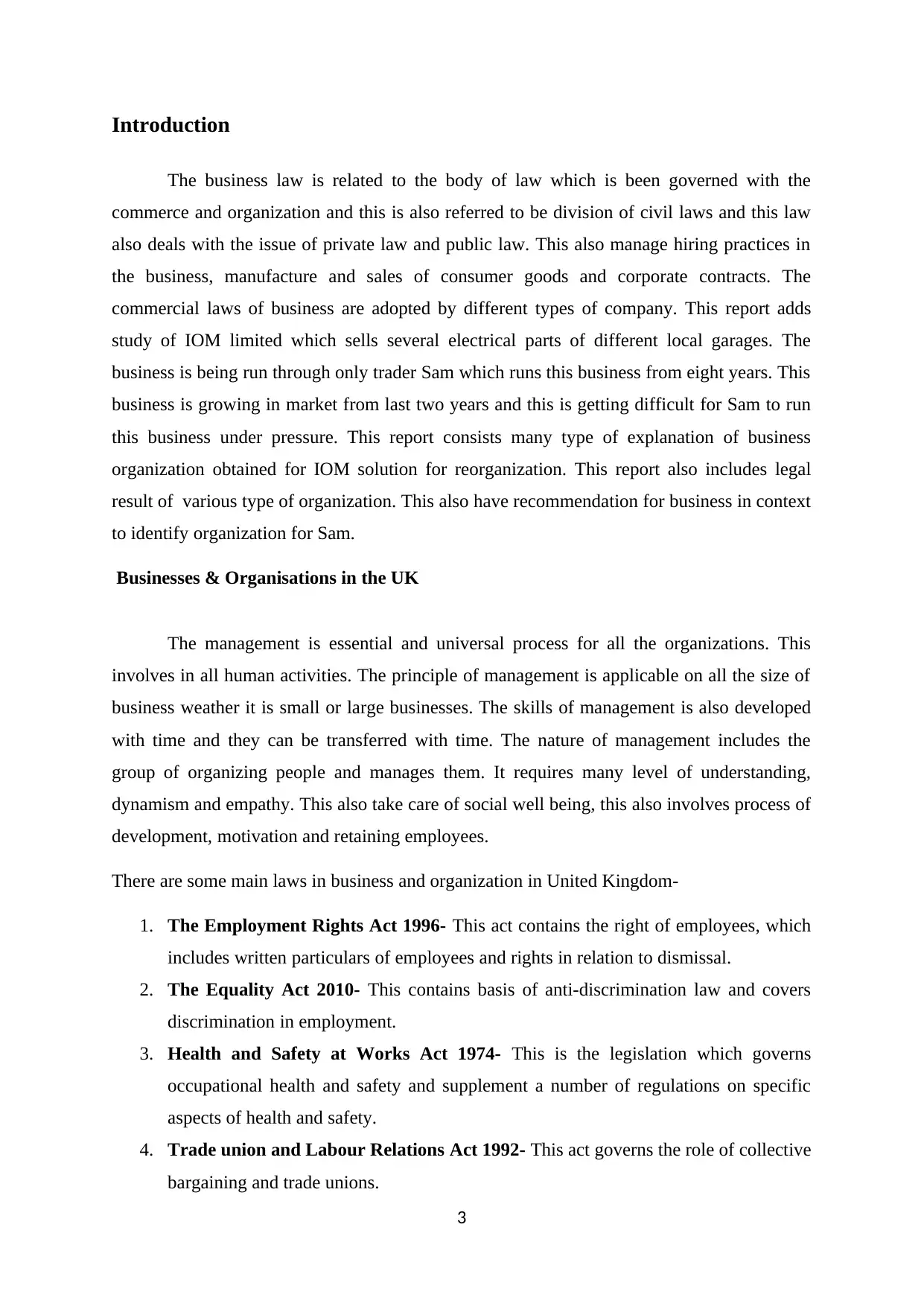
Introduction
The business law is related to the body of law which is been governed with the
commerce and organization and this is also referred to be division of civil laws and this law
also deals with the issue of private law and public law. This also manage hiring practices in
the business, manufacture and sales of consumer goods and corporate contracts. The
commercial laws of business are adopted by different types of company. This report adds
study of IOM limited which sells several electrical parts of different local garages. The
business is being run through only trader Sam which runs this business from eight years. This
business is growing in market from last two years and this is getting difficult for Sam to run
this business under pressure. This report consists many type of explanation of business
organization obtained for IOM solution for reorganization. This report also includes legal
result of various type of organization. This also have recommendation for business in context
to identify organization for Sam.
Businesses & Organisations in the UK
The management is essential and universal process for all the organizations. This
involves in all human activities. The principle of management is applicable on all the size of
business weather it is small or large businesses. The skills of management is also developed
with time and they can be transferred with time. The nature of management includes the
group of organizing people and manages them. It requires many level of understanding,
dynamism and empathy. This also take care of social well being, this also involves process of
development, motivation and retaining employees.
There are some main laws in business and organization in United Kingdom-
1. The Employment Rights Act 1996- This act contains the right of employees, which
includes written particulars of employees and rights in relation to dismissal.
2. The Equality Act 2010- This contains basis of anti-discrimination law and covers
discrimination in employment.
3. Health and Safety at Works Act 1974- This is the legislation which governs
occupational health and safety and supplement a number of regulations on specific
aspects of health and safety.
4. Trade union and Labour Relations Act 1992- This act governs the role of collective
bargaining and trade unions.
3
The business law is related to the body of law which is been governed with the
commerce and organization and this is also referred to be division of civil laws and this law
also deals with the issue of private law and public law. This also manage hiring practices in
the business, manufacture and sales of consumer goods and corporate contracts. The
commercial laws of business are adopted by different types of company. This report adds
study of IOM limited which sells several electrical parts of different local garages. The
business is being run through only trader Sam which runs this business from eight years. This
business is growing in market from last two years and this is getting difficult for Sam to run
this business under pressure. This report consists many type of explanation of business
organization obtained for IOM solution for reorganization. This report also includes legal
result of various type of organization. This also have recommendation for business in context
to identify organization for Sam.
Businesses & Organisations in the UK
The management is essential and universal process for all the organizations. This
involves in all human activities. The principle of management is applicable on all the size of
business weather it is small or large businesses. The skills of management is also developed
with time and they can be transferred with time. The nature of management includes the
group of organizing people and manages them. It requires many level of understanding,
dynamism and empathy. This also take care of social well being, this also involves process of
development, motivation and retaining employees.
There are some main laws in business and organization in United Kingdom-
1. The Employment Rights Act 1996- This act contains the right of employees, which
includes written particulars of employees and rights in relation to dismissal.
2. The Equality Act 2010- This contains basis of anti-discrimination law and covers
discrimination in employment.
3. Health and Safety at Works Act 1974- This is the legislation which governs
occupational health and safety and supplement a number of regulations on specific
aspects of health and safety.
4. Trade union and Labour Relations Act 1992- This act governs the role of collective
bargaining and trade unions.
3
Paraphrase This Document
Need a fresh take? Get an instant paraphrase of this document with our AI Paraphraser

The business management transaction is also known as business transaction monitoring,
this manages Information Technology from perspective of a business transaction. This also
provides tracking flow tools of IT infrastructure. This also provide visibility in flow of
transaction and also includes application topology for dynamic mapping. The main target of
business management transaction is to maintain service quality for the user who conducts
business transaction and they also improve the IT applications effectiveness and
infrastructure to which the transaction execute. The main benefit of this is to identify the
transaction and delay in the IT infrastructure. The doctrine of Vicarious Liability under
English tort law imposes strict liability on employer for wrongdoer in regards to there
employees. In general the act of employer will held liable for any of the tort committed
against an employee for conducting their duties. This is being held that the most intentional
wrongdoing were not happen in the ordinary course of employment, in the recent case law
this is being suggested that the action is connected closely with the duties of employee, then
the employer will be found vicarious liable.
The law has given company an separate legal entity, which have there own right and
responsibilities. This is the fact that a company is separate from the person who carries out
the running of business which causes difficulties for the wrongful act carried out by the
natural persons. If the companies have separate legal entity then they should be held liable for
their negligent acts in the same manner as a natural person. Due to company’s legal
recognitions as artificial entities other than natural persons they were not held liable for their
negligent act. A company is run through two main bodies of people that is the shareholder
and the board of directors. The management of a company is under the control of Board of
directors, the directors will make all the strategic and operational decision for the company
and they are responsible to ensure the company will meet its statutory obligations. The role of
a director is to be present in meeting and ensure the board to reach their decision and will
make sure that the company will fulfill the obligations. Mainly the directors are the agent of a
company, they were appointed by the shareholders to manage the company. The main rule is
that the directors have to act together and maintain the board but the board may also transfer
some of the power the individual directors of the committee of board. They also have to be a
shareholder of the company, and also have additional right and duties which goes beyond the
directors office. They have to act within the constitution of the company, which power its
constitution gives to the director, they will exercise the power within the limit.
4
this manages Information Technology from perspective of a business transaction. This also
provides tracking flow tools of IT infrastructure. This also provide visibility in flow of
transaction and also includes application topology for dynamic mapping. The main target of
business management transaction is to maintain service quality for the user who conducts
business transaction and they also improve the IT applications effectiveness and
infrastructure to which the transaction execute. The main benefit of this is to identify the
transaction and delay in the IT infrastructure. The doctrine of Vicarious Liability under
English tort law imposes strict liability on employer for wrongdoer in regards to there
employees. In general the act of employer will held liable for any of the tort committed
against an employee for conducting their duties. This is being held that the most intentional
wrongdoing were not happen in the ordinary course of employment, in the recent case law
this is being suggested that the action is connected closely with the duties of employee, then
the employer will be found vicarious liable.
The law has given company an separate legal entity, which have there own right and
responsibilities. This is the fact that a company is separate from the person who carries out
the running of business which causes difficulties for the wrongful act carried out by the
natural persons. If the companies have separate legal entity then they should be held liable for
their negligent acts in the same manner as a natural person. Due to company’s legal
recognitions as artificial entities other than natural persons they were not held liable for their
negligent act. A company is run through two main bodies of people that is the shareholder
and the board of directors. The management of a company is under the control of Board of
directors, the directors will make all the strategic and operational decision for the company
and they are responsible to ensure the company will meet its statutory obligations. The role of
a director is to be present in meeting and ensure the board to reach their decision and will
make sure that the company will fulfill the obligations. Mainly the directors are the agent of a
company, they were appointed by the shareholders to manage the company. The main rule is
that the directors have to act together and maintain the board but the board may also transfer
some of the power the individual directors of the committee of board. They also have to be a
shareholder of the company, and also have additional right and duties which goes beyond the
directors office. They have to act within the constitution of the company, which power its
constitution gives to the director, they will exercise the power within the limit.
4
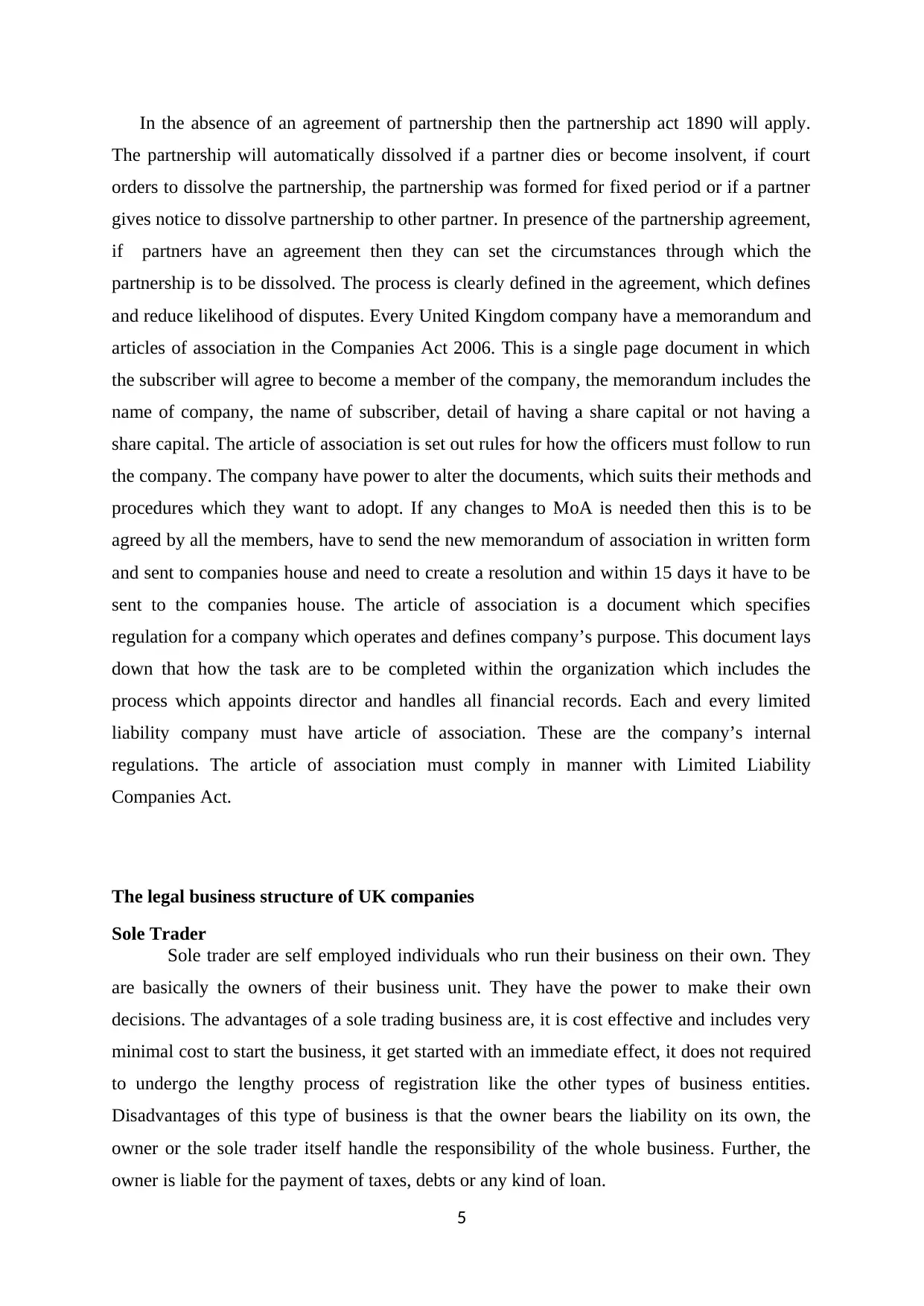
In the absence of an agreement of partnership then the partnership act 1890 will apply.
The partnership will automatically dissolved if a partner dies or become insolvent, if court
orders to dissolve the partnership, the partnership was formed for fixed period or if a partner
gives notice to dissolve partnership to other partner. In presence of the partnership agreement,
if partners have an agreement then they can set the circumstances through which the
partnership is to be dissolved. The process is clearly defined in the agreement, which defines
and reduce likelihood of disputes. Every United Kingdom company have a memorandum and
articles of association in the Companies Act 2006. This is a single page document in which
the subscriber will agree to become a member of the company, the memorandum includes the
name of company, the name of subscriber, detail of having a share capital or not having a
share capital. The article of association is set out rules for how the officers must follow to run
the company. The company have power to alter the documents, which suits their methods and
procedures which they want to adopt. If any changes to MoA is needed then this is to be
agreed by all the members, have to send the new memorandum of association in written form
and sent to companies house and need to create a resolution and within 15 days it have to be
sent to the companies house. The article of association is a document which specifies
regulation for a company which operates and defines company’s purpose. This document lays
down that how the task are to be completed within the organization which includes the
process which appoints director and handles all financial records. Each and every limited
liability company must have article of association. These are the company’s internal
regulations. The article of association must comply in manner with Limited Liability
Companies Act.
The legal business structure of UK companies
Sole Trader
Sole trader are self employed individuals who run their business on their own. They
are basically the owners of their business unit. They have the power to make their own
decisions. The advantages of a sole trading business are, it is cost effective and includes very
minimal cost to start the business, it get started with an immediate effect, it does not required
to undergo the lengthy process of registration like the other types of business entities.
Disadvantages of this type of business is that the owner bears the liability on its own, the
owner or the sole trader itself handle the responsibility of the whole business. Further, the
owner is liable for the payment of taxes, debts or any kind of loan.
5
The partnership will automatically dissolved if a partner dies or become insolvent, if court
orders to dissolve the partnership, the partnership was formed for fixed period or if a partner
gives notice to dissolve partnership to other partner. In presence of the partnership agreement,
if partners have an agreement then they can set the circumstances through which the
partnership is to be dissolved. The process is clearly defined in the agreement, which defines
and reduce likelihood of disputes. Every United Kingdom company have a memorandum and
articles of association in the Companies Act 2006. This is a single page document in which
the subscriber will agree to become a member of the company, the memorandum includes the
name of company, the name of subscriber, detail of having a share capital or not having a
share capital. The article of association is set out rules for how the officers must follow to run
the company. The company have power to alter the documents, which suits their methods and
procedures which they want to adopt. If any changes to MoA is needed then this is to be
agreed by all the members, have to send the new memorandum of association in written form
and sent to companies house and need to create a resolution and within 15 days it have to be
sent to the companies house. The article of association is a document which specifies
regulation for a company which operates and defines company’s purpose. This document lays
down that how the task are to be completed within the organization which includes the
process which appoints director and handles all financial records. Each and every limited
liability company must have article of association. These are the company’s internal
regulations. The article of association must comply in manner with Limited Liability
Companies Act.
The legal business structure of UK companies
Sole Trader
Sole trader are self employed individuals who run their business on their own. They
are basically the owners of their business unit. They have the power to make their own
decisions. The advantages of a sole trading business are, it is cost effective and includes very
minimal cost to start the business, it get started with an immediate effect, it does not required
to undergo the lengthy process of registration like the other types of business entities.
Disadvantages of this type of business is that the owner bears the liability on its own, the
owner or the sole trader itself handle the responsibility of the whole business. Further, the
owner is liable for the payment of taxes, debts or any kind of loan.
5
⊘ This is a preview!⊘
Do you want full access?
Subscribe today to unlock all pages.

Trusted by 1+ million students worldwide

General Partnership
General partnership is one in which the partners holds the ability to take part in the
managerial functions of the business. They can exercise their control on the business. Every
owner have the authority to take the decisions regarding any kind of business activity and
also they can also make the legal decisions in their capacity. Until, the partnership have an
agreement, each partner will enjoy equal authority. In this type of partnership, each and every
partner is jointly and severably liable for the debts and for the payment of taxes. Advantages
are, it is very easy to create, it is flexible in nature. Disadvantages are, it can be easily
dissolve, there is no formal or legal protection in terms of the joint liability.
Partnership
Partnership is formed by two or more individuals in order to formulate the business
structure. It is not required to gets registered under the state authority. All the partners shares
the rights and duties equally. They are responsible for the business operations on the same
footing. Advantages are, it includes very less legal formalities, the burden of responsibilities
to carry out business activities is divided between each of the partners equally. Disadvantages
are, this type of business does not hold any independent legal status, the partners are
personally liable for the debts and losses of the firm.
Limited Liability
Limited liability is a form of business in which the liability of the partners are limited.
They also have financial advantage. They are also saved from double tax system under which
the partners are liable to pay taxes in the name of the company as well as in the name of the
partnership. Advantages are, it carries no limit on the number of partners in the business,
rebate from double taxation system. Disadvantages are, the partnership get dissolved if any
one member decides to leave the partnership firm, the personal financial income get taxed.
Recommendations for IOM Solutions
It is suggested for IOM solution to go for the partnership business so as to lessen the
pressure an d reduce the burden to meet the market demands. The reason behind choosing
partnership as a business type because the formation could be easily done without less
paperwork. It requires no legal formalities to be fulfilled like other business types. The
partners share equal rights and duties and are responsible for each task performed in the name
of business operations.
6
General partnership is one in which the partners holds the ability to take part in the
managerial functions of the business. They can exercise their control on the business. Every
owner have the authority to take the decisions regarding any kind of business activity and
also they can also make the legal decisions in their capacity. Until, the partnership have an
agreement, each partner will enjoy equal authority. In this type of partnership, each and every
partner is jointly and severably liable for the debts and for the payment of taxes. Advantages
are, it is very easy to create, it is flexible in nature. Disadvantages are, it can be easily
dissolve, there is no formal or legal protection in terms of the joint liability.
Partnership
Partnership is formed by two or more individuals in order to formulate the business
structure. It is not required to gets registered under the state authority. All the partners shares
the rights and duties equally. They are responsible for the business operations on the same
footing. Advantages are, it includes very less legal formalities, the burden of responsibilities
to carry out business activities is divided between each of the partners equally. Disadvantages
are, this type of business does not hold any independent legal status, the partners are
personally liable for the debts and losses of the firm.
Limited Liability
Limited liability is a form of business in which the liability of the partners are limited.
They also have financial advantage. They are also saved from double tax system under which
the partners are liable to pay taxes in the name of the company as well as in the name of the
partnership. Advantages are, it carries no limit on the number of partners in the business,
rebate from double taxation system. Disadvantages are, the partnership get dissolved if any
one member decides to leave the partnership firm, the personal financial income get taxed.
Recommendations for IOM Solutions
It is suggested for IOM solution to go for the partnership business so as to lessen the
pressure an d reduce the burden to meet the market demands. The reason behind choosing
partnership as a business type because the formation could be easily done without less
paperwork. It requires no legal formalities to be fulfilled like other business types. The
partners share equal rights and duties and are responsible for each task performed in the name
of business operations.
6
Paraphrase This Document
Need a fresh take? Get an instant paraphrase of this document with our AI Paraphraser
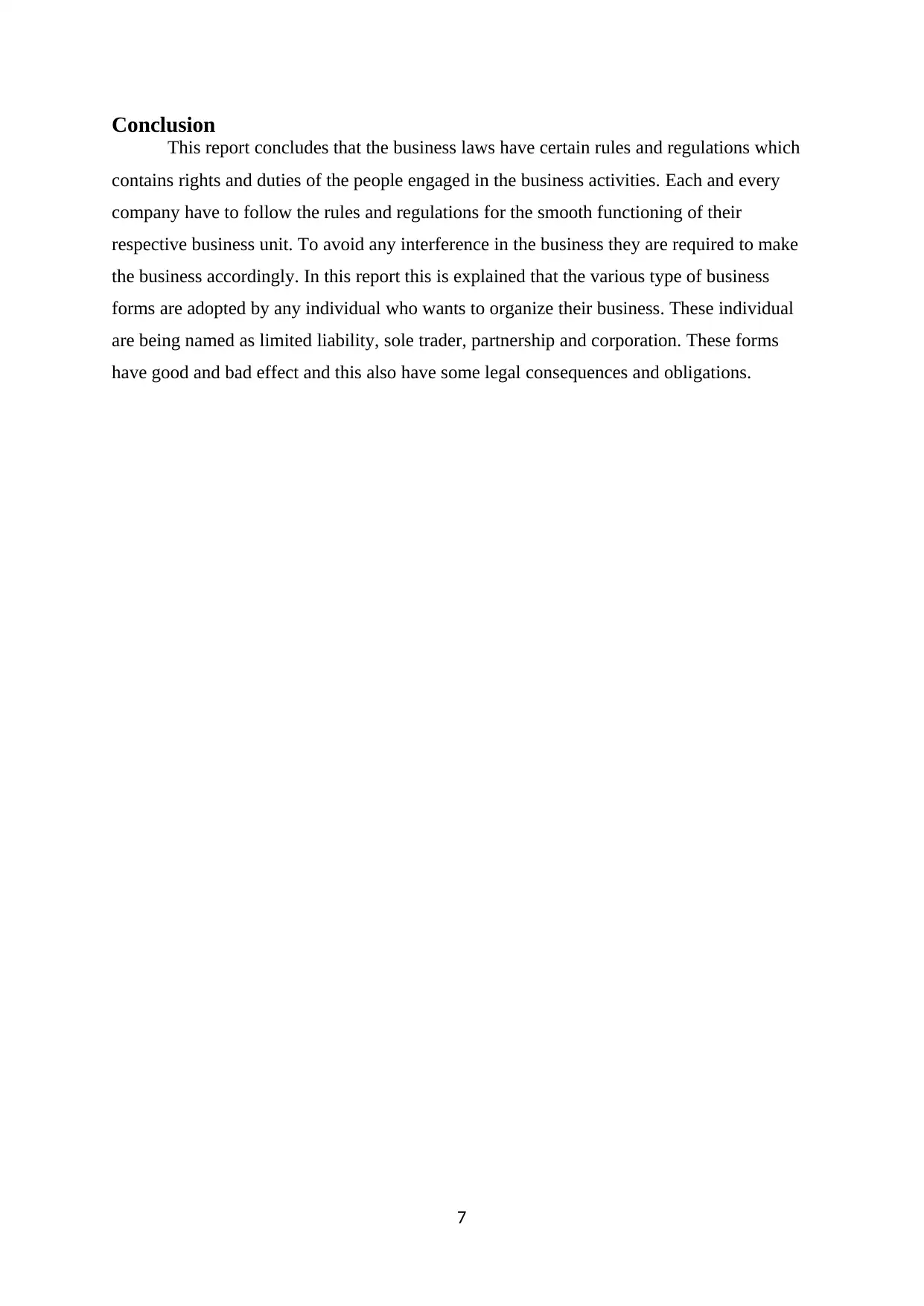
Conclusion
This report concludes that the business laws have certain rules and regulations which
contains rights and duties of the people engaged in the business activities. Each and every
company have to follow the rules and regulations for the smooth functioning of their
respective business unit. To avoid any interference in the business they are required to make
the business accordingly. In this report this is explained that the various type of business
forms are adopted by any individual who wants to organize their business. These individual
are being named as limited liability, sole trader, partnership and corporation. These forms
have good and bad effect and this also have some legal consequences and obligations.
7
This report concludes that the business laws have certain rules and regulations which
contains rights and duties of the people engaged in the business activities. Each and every
company have to follow the rules and regulations for the smooth functioning of their
respective business unit. To avoid any interference in the business they are required to make
the business accordingly. In this report this is explained that the various type of business
forms are adopted by any individual who wants to organize their business. These individual
are being named as limited liability, sole trader, partnership and corporation. These forms
have good and bad effect and this also have some legal consequences and obligations.
7
1 out of 8
Related Documents
Your All-in-One AI-Powered Toolkit for Academic Success.
+13062052269
info@desklib.com
Available 24*7 on WhatsApp / Email
![[object Object]](/_next/static/media/star-bottom.7253800d.svg)
Unlock your academic potential
Copyright © 2020–2025 A2Z Services. All Rights Reserved. Developed and managed by ZUCOL.